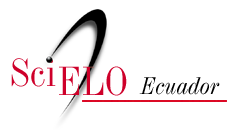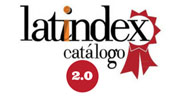Estudio de las condiciones de trabajo en bibliotecas de la ciudad de Quito y la exposición de sus trabajadores a hongos
DOI:
https://doi.org/10.29019/enfoqueute.v8n2.160Palabras clave:
biblioteca, exposición, riesgo biológico, carga microbiana, bienes documentalesResumen
El objetivo fue establecer los determinantes de riesgo en los trabajadores de bibliotecas de la ciudad Quito, debido a su exposición a hongos. Se recolectaron datos sobre condiciones de infraestructura y organización del trabajo, medidas de temperatura, humedad relativa, iluminación y ventilación. Se determinó la carga microbiana de hongos en aire, superficies de bienes documentales y guantes de manipuladores; en 5 bibliotecas de la Universidad Tecnológica Equinoccial, sede Quito. Se encontró que la temperatura y humedad relativa de los ambientes son adecuadas. El sistema de ventilación es deficiente y facilita acumulación de polvo en los bienes documentales. Los trabajadores desconocen procedimientos de prevención de riesgos. La contaminación microbiana es baja en el aire y alta en los guantes de los manipuladores; en los libros la carga microbiana tiene relación directa con la cantidad de polvo acumulado. Se caracterizaron géneros de hongos patógenos oportunistas, alergénicos, como: Cladosporium, Aspergillus y Penicillium, entre otros. En conclusión, el riesgo biológico por exposición a hongos es moderado, determinado por: falta de ventilación y programas de conservación preventiva de los bienes documentales, planes de mantenimiento de instalaciones y capacitación en seguridad y riesgos del trabajo. La vía de exposición es por contacto con el material contaminado.
Descargas
Referencias
Borrell Saburit, A., Cueto González, A. E., Castillo Navarrete, D., & Mazorra Fernández, Y. (2004). Lineamientos para la conservación de documentos en la Biblioteca Médica Nacional de Cuba. Acimed, 12(5), 1-1. http://scielo.sld.cu/pdf/aci/v12n5/aci12504.pdf
Bueno, D., Silva, J., Oliver, G., (2003), Hongos ambientales en una biblioteca, un año de estudio, Anales de documentación, n° 6, edit.um, Ediciones de la Universidad de Murcia, disponible en: www.revistas.um.es/analesdoc/ article/view/2061.
Caneva G, Nugari M.P., Salvadori O., (1.991), Biology in the Conservation of Works of Art , Rome, Italy, Sintesi grafica s.r.l
Cid Munguia, A., (2008). Medidas preventivas para la preservación de la información en materiales impresos, Universidad Nacional de México D. F. disponible en: www.filos.unam.mx/LICENCIATURA/.../cid-munguia-alfonso.
Dante J., Silva J., & Oliver G., (2003). Hongos ambientales en una Biblioteca: Un año de estudio, Anales de documentación N° 6, Tucumán, Argentina, pp. 27-34. [On line] Disponible en: http://revistas.um.es/analesdoc/article/view/2061/2051
Guerrero Pupo, J. C., Amell Muñoz, I., & Cañedo Andalia, R. (2004). Salud ocupacional: nociones útiles para los profesionales de la información. Acimed,12(5), 1-1.
Hernández, A., (2002), NTP 608 Agentes biológicos: planificación de la medición, INSHT, Madrid. Recuperado de: http://www.insht.es/InshtWeb/Contenidos/ Documentacion/FichasTecnicas/NTP/Ficheros/201a300/ntp_608.pdf
López, A., Ruiz, A., Petlacalco, B., Díaz, K., Guadalupe, J., Rivera, J., (2011), Estudio microbiológico de la biblioteca “Lafragua” de la Benemérita Universidad Autónoma de Puebla, México, Rev. Med. UAS Nueva época, Vol. 2: N° 3, pp. 82-83.
Mateus, J., Peña, D., Peña, G., Rojas, A., Rojas, J., Zambrano, S., Martínez, M., Flórez, C., Santander, M., (2001), “Seguimiento y control de biodeterioro microbiológico en documentos de interés histórico en el archivo general de la nación”, Revista Universitas Scientiarum, Facultad de Ciencias Pontificia Universidad de Colombia. Recuperado el 5 de mayo del 2014. http://www.javeriana.edu.co/universitas_scientiarum/universitas_docs/vol9n1/articulo%205.pdf
Martí, M., (1991), NTP 299 Método para el recuento de bacterias y hongos en aire, INSHT, Madrid. Recuperado de http://www.insht.es/InshtWeb/ Contenidos/Documentacion/FichasTecnicas/NTP/Ficheros/201a300/ntp_299.pdf
Martín, S. I. (2014). Diversidad microbiana y taxonomía, (en línea). Universidad de Granada. Departamento de microbiología. Disponible en: www.diversidadmicrobiana.com/index.php?option=com_content&view=article&id=127&Itemid=1
Medina, L., Tuozzo, A., Herrera, J., Perozo, y., González, L., (1999), “Estudio de hongos en la Biblioteca de la Universidad de Carabobo-Valencia”, Universidad de Carabobo. Vol. 3, N° 1. Disponible en: http://servicio.bc.uc.edu.ve/fcs/ vol3n1/3estu.pdf
Organización Mundial de la Salud OMS, (2005). Manual de Bioseguridad en el Laboratorio, 3° Edición, Ginebra. (en línea) disponible en: http://www.who.int/csr/resources/publications/biosafety/CDS_CSR_LYO_2004_11SP.pdf
Valentín, N., (2004), Biodeterioro de los materiales de archivos y museos, conservación y prevención, Instituto de Patrimonio Histórico Español. [On line] Disponible en http://www.aecidcf.org.co/documentos/MI%2018.283%20Valentin,%20Nieves.%20Biodeteriro.pdf.
Villalba, L. S., Milkán, J. F., Sánchez, J. (2004), Actividades hidrolíticas y caracterización isoenzimática de poblaciones microbianas aisladas del patrimonio documental del Archivo General de Colombia, NOVA Vol. 2, No 2, pp. 50-57. Recuperado 4 de mayo de 2014 http://scielo.unam.mx/pdf/rmm/v29/v29a3.pdf
Publicado
Número
Sección
Licencia
Los autores retienen todos sus derechos (© copyright).
- Los autores retienen sus derechos de marca y patente, y también sobre cualquier proceso o procedimiento descrito en el artículo.
- Los autores retienen el derecho de compartir, copiar, distribuir, ejecutar y comunicar públicamente el artículo publicado en Enfoque UTE (por ejemplo, colocarlo en un repositorio institucional o publicarlo en un libro), siempre que se dé el reconocimiento de su publicación inicial en la revista Enfoque UTE.
- Los autores retienen el derecho a hacer una posterior publicación de su trabajo, de utilizar el artículo o cualquier parte de aquel (por ejemplo: una compilación de sus trabajos, notas para conferencias, tesis, o para un libro), siempre que indiquen la fuente de publicación (autores del trabajo, revista, volumen, número y fecha).
























